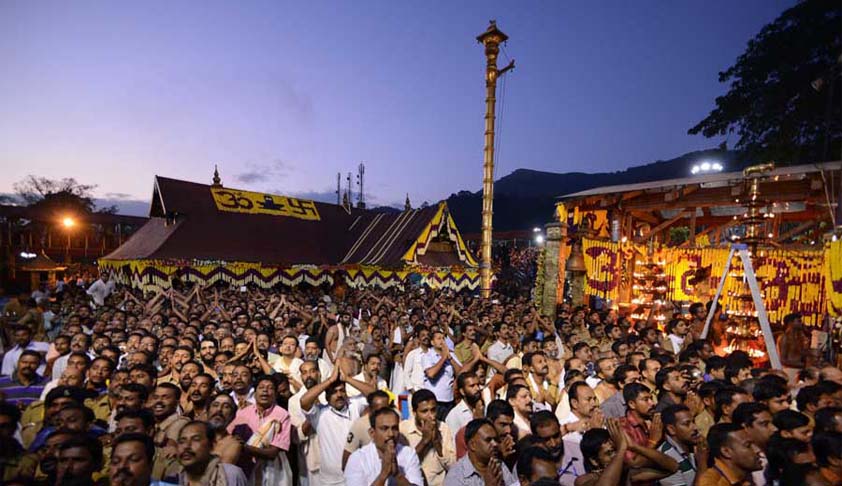- Home
- /
- News Updates
- /
- Supreme Court set to hear the...
Supreme Court set to hear the challenge to Sabarimala Temple's restrictions on Entry of Women
LiveLaw Research Team
11 Jan 2016 3:43 PM GMT
A Supreme Court bench comprising Justices Dipak Misra, Pinaki Chandra Ghose and NV Ramana today briefly heard the writ petition (civil) 373 of 2006 filed by Indian Young Lawyers Association, seeking lifting of the ban on entry of menstruating women to the famous Sabarimala temple. The hearing, which lasted for about half an hour, saw interesting exchanges between Justice Misra and KK...
A Supreme Court bench comprising Justices Dipak Misra, Pinaki Chandra Ghose and NV Ramana today briefly heard the writ petition (civil) 373 of 2006 filed by Indian Young Lawyers Association, seeking lifting of the ban on entry of menstruating women to the famous Sabarimala temple. The hearing, which lasted for about half an hour, saw interesting exchanges between Justice Misra and KK Venugopal, counsel for the Travancore Devaswom Board, which administers the temple. Venugopal referred to the peculiar custom in the temple, associated with the 41 days penance undertaken by the devotees, during which they are under voluntary restraint from indulging in worldly pleasures. He then referred to the Muslim shrine within the temple complex, and the history associated with it, making it a unique characteristic of the temple.
Justice Dipak Misra said he respected Venugopal's knowledge of spiritualism associated with the temple, but in this case, they have to rise above the spiritual considerations, and address the Constitutional issues involved in it. He then referred to the ban on reading of vedas by women, and how that ban, which had no religious sanction, was removed with the progress of mankind. Similarly, he said, it was possible that women had right of entry to the Sabarimala temple at one point of time, but the ban might have gained currency in the intervening years, and it is perhaps time to review it. Justice Misra also observed that the temple can't restrict the right of entry except on the basis of religion, and whether the temple can claim Constitutional protection on the ground of being a separate religious denomination. Justice Misra also asked the counsel to submit whether there is any Constitutional justification for the restriction.
The bench then fixed the next date of hearing the case on 8 February.
The case was referred to the three-Judge bench by a two-Judge bench comprising justices SB Sinha and VS Sirpurkar on 8 March 2008, in view of the serious Constitutional questions involved.
The Association has challenged the validity of Section 3(b) of Kerala Hindu Places of Public Worship (Authorisation of entry) Rules 1965, which facilitates the ban on entry of women to the temple.
In 2008, the then Left Front Government in Kerala had told the Supreme Court that denial of entry of women was a violation of Fundamental Rights. The Court had then expressed its surprise why the State Government did not challenge the 1991 Kerala High Court judgment, which upheld the ban. The present Government has reportedly sought time from the Supreme Court to make a fresh submission in the matter.
The petitioners claim that since the Board received financial assistance of more than Rs.8 lakh per annum from the State, it cannot claim immunity from the Constitutional mandate against discrimination on the basis of sex.
The Kerala High Court, in S Mahendran vs The Secretary, Travancore Devaswom Board, Tiruvanantthapuram and Others, delivered on 5 April 1991, had held that a religious denomination or organisation enjoys complete autonomy n the matter of deciding as to what rites and ceremonies are essential according to the tenets of the religion, under Article 26(b) of the Constitution.
The high court had further held that a religion can not only lay down a code of ethical rules, but it can also prescribe rituals, observances, ceremonies, and modes of worship. These observances and rituals, it said, are also regarded as integral parts of religion.
The reason cited by the Board in defence of the ban before the High Court was that women of the age group 10 to 50 would not be in a position to observe Vratham continuously for a period of 41 days due to physiological reasons.
The High Court also referred to the belief that tthe deity is in the form of a Naisthik Brahmachari, and that young women should not offer worship in the temple so that even the slightest deviation from celebacy and austerity observed by the deity is not caused by the presence of such women. But the high court added that the restriction is prevalent only during Mandalam, Makaravilakku and Vishu days, when there is rush of pilgrims.
The Kerala High Court upheld the ban on the ground that it is in accordance with the usage prevalent from time immemorial, and that he restriction is only in respect of women of a particular age group and not women as a class.
In the Supreme Court today, Justice Dipak Misra observed that if women voluntarily avoid going to the temple, it is another matter. But the High Court's order was surprising because it directed the Board not to permit women above the age of 10 and below the age of 50 to trek the holy hills of Sabarimala and from offering worship at Sabarimala during any period of the year, and directed the Government of Kerala to render all necessary assistance inclusive of police tto see that the direction issued to the Board is complied with. Before the High Court, the petitioner sought a ban, and secured it.


